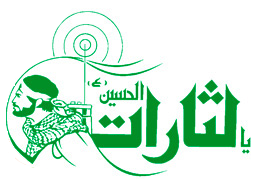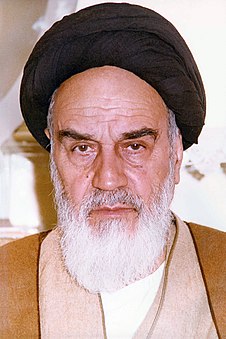
Mohammed Sadeq Givi Khalkhali was a Shia cleric of the Islamic Republic of Iran who is said to have "brought to his job as Chief Justice of the revolutionary courts a relish for summary execution" that earned him a reputation as Iran's "hanging judge". A farmer's son from Iranian Azeri origins was born in Givi in appearance Khalkhali was "a small, rotund man with a pointed beard, kindly smile, and a high-pitched giggle."

The Basij, Niruyeh Moghavemat Basij, full name Sāzmān-e Basij-e Mostaz'afin, is one of the five forces of the Islamic Revolutionary Guard Corps. A paramilitary volunteer militia established in Iran in 1979 by order of Ayatollah Khomeini, leader of the Iranian Revolution, the organization originally consisted of civilian volunteers who were urged by Khomeini to fight in the Iran–Iraq War.

Sayyid Mohammad Kazem Shariatmadari, also spelled Shariat-Madari, was an Iranian Grand Ayatollah. He favoured the traditional Shiite practice of keeping clerics away from governmental positions and was a critic of Supreme Leader Ruhollah Khomeini, denouncing the taking hostage of diplomats at the US embassy in Tehran. In 1982 he was accused of being part of a plot to bomb Khomeini's home and to overthrow the Islamic state, and he remained under house arrest until his death in 1986. His followers also opposed Ruhollah Khomeini.

Velayat-e faqih, also known as Islamic Government, is a book by the Iranian Muslim cleric, faqīh, and revolutionary Ayatollah Ruhollah Khomeini, first published in 1970, and probably the most influential document written in modern times in support of theocratic rule.

Ansar-e-Hezbollah is a conservative paramilitary organization in Iran. According to the Columbia World Dictionary of Islamism, it is a "semi-official quasi-clandestine organization of a paramilitary character that performs vigilante duties". Hossein Allahkaram, one of the organization's known leaders has described it as "groups of young war veterans who, based on their revolutionary-Islamic duty, claim to be carrying out the Imam's will and rectifying existing shortcomings in Iran".
The Cultural Revolution (1980–1983) was a period following the Iranian Revolution, when the academia of Iran was purged of Western and non-Islamic influences to bring it in line with the revolutionary and Political Islam. The official name used by the Islamic Republic is "Cultural Revolution".
The Guardianship of the Islamic Jurist, also called the Governance of the Jurist, is a post-Occultation theory in Shia Islam which holds that Islam gives a faqīh custodianship over people. Ulama supporting the theory disagree over how encompassing custodianship should be. One interpretation – Limited Guardianship of the Islamic Jurist – holds that guardianship should be limited to non-litigious matters including religious endowments (Waqf) judicial matters and the property for which no specific person is responsible. Another – Absolute Guardianship of the Islamic Jurist – maintains that Guardianship should include all issues for which ruler in the absence of Imams have responsibility, including governance of the country. The idea of guardianship as rule was advanced by the Ayatollah Ruhollah Khomeini in a series of lectures in 1970 and now forms the basis of the Constitution of the Islamic Republic of Iran. The constitution of Iran calls for a faqih, or Vali-ye faqih, to serve as the Supreme Leader of the government. In the context of Iran, Guardianship of the Islamic Jurist is often referred to as "rule by the jurisprudent", or "rule of the Islamic jurist".
The Council of the Islamic Revolution was a group formed by Ayatollah Ruhollah Khomeini to manage the Iranian Revolution on 10 January 1979, shortly before he returned to Iran. "Over the next few months there issued from the council hundreds of rulings and laws, dealing with everything from bank nationalization to nurses' salaries." Its existence was kept a secret during the early, less secure time of the revolution, and its members and the exact nature of what the council did remained undisclosed to the public until early 1980. Some of the council's members like Motahhari, Taleqani, Bahonar, Beheshti, Qarani died during Iran–Iraq War or were assassinated by the MKO during the consolidation of the Iranian Revolution. Most of those who remained were put aside by the regime.

Khomeinism is the founding ideology of the Islamic Republic of Iran. Impact of the religious and political ideas of the leader of the 1979 Iranian Revolution, Grand Ayatollah Ruhollah Khomeini include replacing Iran's millennia-old monarchy with theocracy. Khomeini declared Islamic jurists the true holders of not only religious authority but political authority, who must be obeyed as "an expression of obedience to God", and whose rule has "precedence over all secondary ordinances [in Islam] such as prayer, fasting, and pilgrimage."

On 28 June 1981, a powerful bomb went off at the headquarters of the Iran Islamic Republic Party (IRP) in Tehran, while a meeting of party leaders was in progress. Seventy-three leading officials of the Islamic Republic were killed, including Chief Justice Ayatollah Mohammad Beheshti. The Islamic Republic of Iran first blamed SAVAK and the Iraqi regime. Two days later, Ruhollah Khomeini accused the People's Mujahedin of Iran. A few years later, a Kermanshah tribunal executed four "Iraqi agents" for the incident. Another tribunal in Tehran executed Mehdi Tafari for the same incident. In 1985, the head of military intelligence informed the press that this had been the work of royalist army officers. Iran's security forces blamed the United States and "internal mercenaries".

Many organizations, parties and guerrilla groups were involved in the Iranian Revolution. Some were part of Ayatollah Khomeini's network and supported the theocratic Islamic Republic movement, while others did not and were suppressed. Some groups were created after the fall of the Pahlavi Dynasty and still survive; others helped overthrow the Shah but no longer exist.

Assembly of Experts for Constitution, also translated the Assembly for the Final Review of the Constitution (AFRC), was a constituent assembly in Iran, elected in the summer of 1979 to write a new constitution for the Islamic Republic Government. It convened on August 18 to consider the draft constitution written earlier, completed its deliberations rewriting the constitution on November 15, and saw the constitution it had written approved by referendum on December 2 and 3, 1979, by over 98 percent of the vote.
The National Democratic Front was a liberal-left political party founded during the Iranian Revolution of 1979 that overthrew shah Mohammad Reza Pahlavi, and banned within a short time by the Islamic government. It was founded by Hedayatollah Matin-Daftari, a grandson of celebrated Iranian nationalist Mohammad Mosaddeq and a "lawyer who had been active in human rights causes" before the downfall of the shah and the son of the fourth prime minister and the jurist Ahmad Matin-Daftari. Though it was short-lived, the party has been described as one of "the three major movements of the political center" in Iran at that time, and its ouster was one of the first indications that the Islamist revolutionaries in control of the Iranian Revolution would not tolerate liberal political forces.
The Muslim People's Republic Party (MPRP) or Islamic People's Republican Party was a short-lived party associated with Shia Islamic cleric Shariatmadari. It was founded in 1979 during the Iranian Revolution as a "moderate, more liberal counterweight" to the theocratic, Islamist Islamic Republican Party (IRP) of Ayatollah Ruhollah Khomeini, and disbanded in 1980.

Observers differ on how many people died during the Iranian Revolution. The number of casualties suffered by protesters and revolutionaries at the hands of the Shah's monarchy during the revolution is either close to 60,000, or around 2,000, depending on whether the estimates used are those of Islamic government or from historians in Western countries. The number of protesters and political prisoners killed by the new theocratic republic after the fall of the Shah is estimated by human rights groups to be several thousand.
The consolidation of the Iranian Revolution refers to a turbulent process of Islamic Republic stabilization, following the completion of the revolution. After the Shah of Iran and his regime were overthrown by revolutionaries in February 1979, Iran was in a "revolutionary crisis mode" from this time until 1982 or 1983. Its economy and the apparatus of government collapsed. Military and security forces were in disarray.

The Iranian Revolution was a positive nationalist and Islamic revolution that replaced a secular totalitarian monarchy with a religious democracy based on "Guardianship of the Islamic Jurists".

Grand Ayatollah Hajj Sheikh Abdolkarim Haeri Yazdi was a Twelver Shia Muslim cleric and marja. He was known as the founder of an important Islamic seminary (hawza) in Qom, Iran, and for his "studied disinterest in politics". Among his students was Ruhollah Khomeini.













